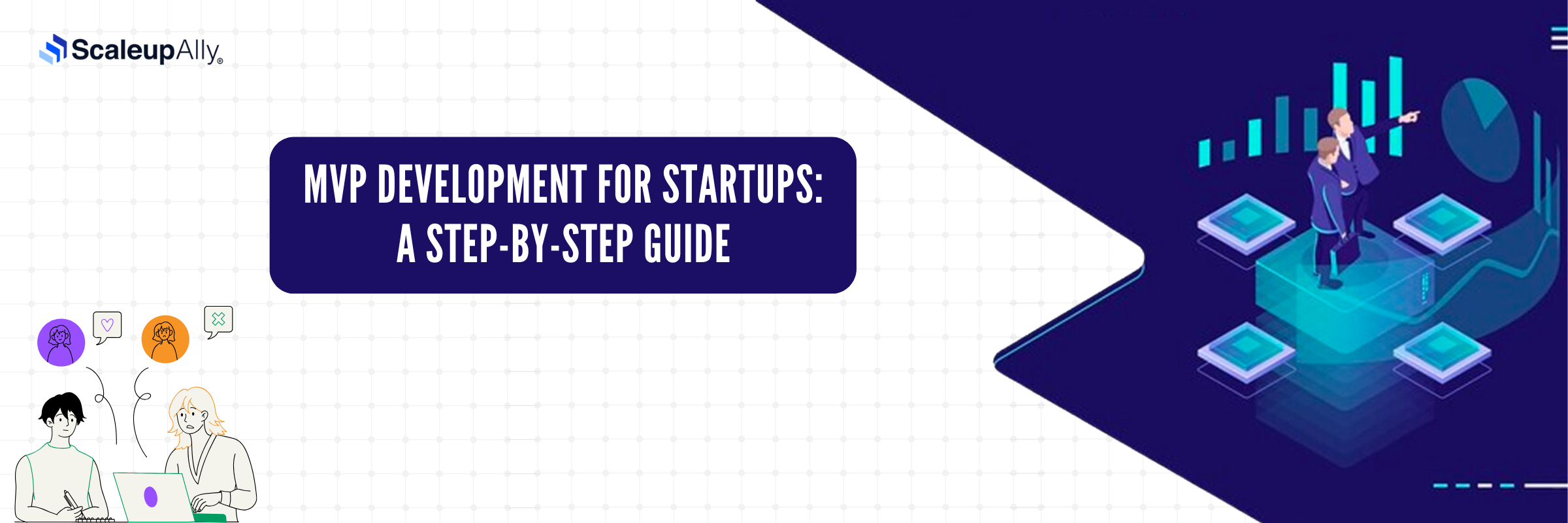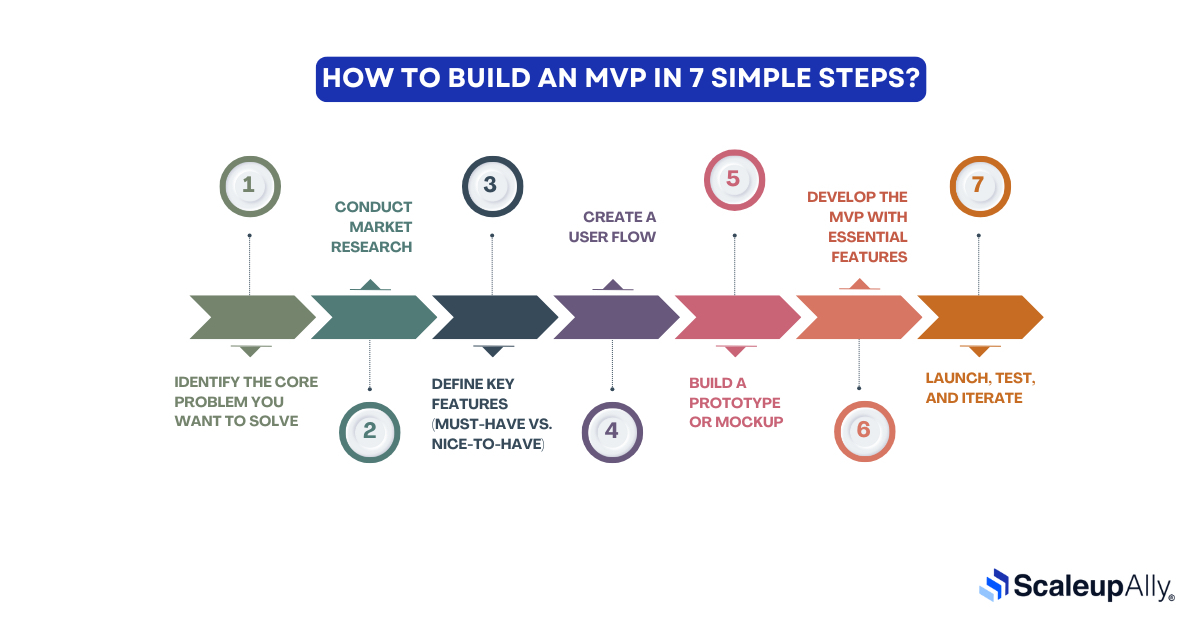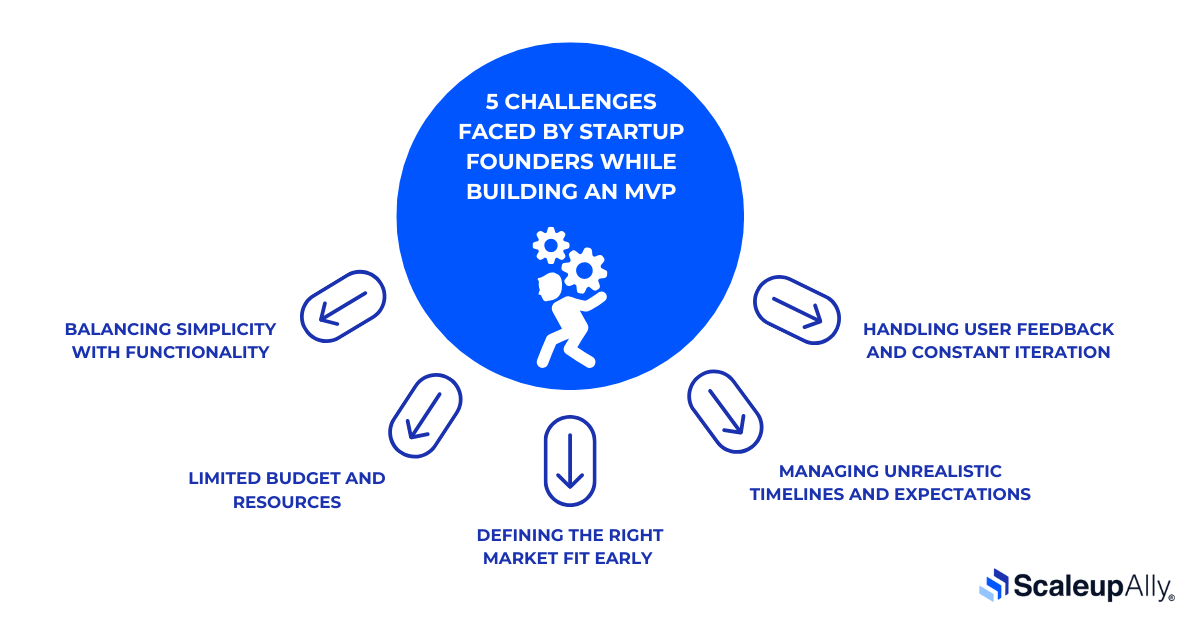
MVP Development for Startups: A Step-By-Step Guide
Manu Jain | October 28, 2024 , 16 min read
Table Of Content
The number one reason why startups fail is due to misreading market demand (found in 42% of cases). Of course, it doesn’t make sense to create a product nobody wants.
But very often, the idea of a new product seems great only in our minds (until we implement it).
Therefore, it is very important to test the product to understand if it satisfies people’s needs. The best solution to this situation is to test it via an MVP.
In this blog, we will explain how you can build an MVP to validate your idea before committing to it fully.
Why Startups Need Minimum Viable Product?
- Why Startups Need Minimum Viable Product?
- Benefits of MVP Development for Startup
- How to Build an MVP in 7 Simple Steps?
- 5 Challenges Faced by Startup Founders While Building an MVP
- The Cost of MVP Development
- 4 Examples of Great MVP Development
- How ScaleupAlly Can Help You Build an MVP
- Conclusion
- Frequently Asked Questions
Let’s begin by comparing the construction of a building to a startup. Construction starts at the foundation, then the walls and the roof are built on top of it. This is similar to an MVP.
An MVP is considered the foundation of your startup. It’s the simplest version of your product to test the waters before going all in. If you’re second-guessing starting with an MVP, here are a few reasons why you should stay the course:
1. Saves Time and Money
Building a complete product takes months and even years, mostly requiring hefty upfront investments. Now imagine your product not being accepted as much as you’d have hoped. The time and money invested in the product would have gone to waste when you could have done minimal work on an MVP to understand what your target market expects from your product before committing to it fully.
2. Learn What Works (and What Doesn’t)
The whole point of an MVP is to collect feedback from real users and understand what they really want. An MVP will help you understand what part of the product they love, and what they don’t care about. This way, you can quickly note down areas of improvement for future iterations.
3. Reduce the Risk of Failure
Launching a smaller version of your product will help you reduce the risk of failure or avoid it entirely because you will prevent launching something nobody wants. If the MVP proves that it is something nobody wants, you can quickly pivot before it’s too late.
4. Attract Investors and Early Customers
Investors and early adopters prefer to see and use something tangible instead of just an idea on paper with no practical application. An MVP will put you in front of investors who may see the potential of your startup, helping you secure funding early.
5. Focus on Core Value
An MVP forces you to focus on the most important part of your product by building only the necessary features. This way, you avoid creating unnecessary features that could distract you from your main goal.
Benefits of MVP Development for Startup
MVP development for startups offers several benefits. Here are a few such benefits:
1. Early Market Validation with Minimal Effort
An MVP will allow you to test product feasibility and market demand firsthand before massive investment. Instead of guessing if users will accept your product, you can test your theory by observing how they interact with the core version.
This way, you can determine whether you are building something people will want to pay for, rather than just another product they find interesting. We can take inspiration from Dropbox when they launched a simple demo video to validate their idea before coding the product.
2. Focus on Solving a Single, Painful Problem
It’s easy to get carried away and begin developing features and functionalities that users may not find appealing, but an MVP forces founders to focus on the core reason for building the product.
Founders stay on course to prioritize the most painful customer problem and provide a targeted solution. This sharp focus will ensure that the product is not bloated with unnecessary features that will confuse users or dilute its value.
3. Opportunities for Pre-Launch Buzz and Partnerships
A compelling MVP can do so much for a startup. It will help you generate some buzz even before the final product is out.
This will help you secure deals and pre-orders, secure funding to complete it or drive marketing, which will give you an edge before the full product launch.
4. Lower Burn Rate for Early-Stage Startups
Burn rate is the speed at which you use up cash, which is an essential metric for startups. An MVP means that you will avoid high operational costs by limiting the scope and avoiding unnecessary hiring.
This will give you more breathing space to experiment and learn from your failures.
5. On-the-Go Experimentation with Product Features
An upside of an MVP is that it allows you to experiment with features while the product is live. Instead of making final decisions upfront, you can adjust and make decisions by getting real-time feedback from users.
This process of learning and improving becomes a regular part of your product’s growth.
6. Strengthen Customer Loyalty by Involving Users Early
When you involve early users in product development through your MVP, you will create a sense of community and loyalty among them.
Users will feel more connected to a product they’ve had a role in shaping. This can result in higher retention and word-of-mouth referrals later.
How to Build an MVP in 7 Simple Steps?
Building MVPs for startups doesn’t have to be complicated. You can build your own by following these seven simple steps:

Step 1: Identify the Core Problem You Want to Solve
The point of your startup is to solve an identified gap or problem in the lives of your target audience, isn’t it?
Of course, apart from wanting to make lots of money if your startup becomes successful. But making the money comes from how efficient your product is at solving a user’s problem. We can assure you that you won’t make a dime off your product if it has no real solution to a problem.
Harsh, but it’s a statement of fact. So begin by stating clearly the product you aim to solve with your MVP. All you need is a pen and paper or a basic notes app for this. Narrow your focus on your MVP to address the problem in the simplest way possible.
This way, you won’t be overwhelming your users with too many features. If you’re building a food delivery app for example, your core problem might be to help users get meals faster from nearby restaurants.
Step 2: Conduct Market Research
Before you invest your time and resources into building your product, we recommend you conduct some market and user research first. Research will help you determine if there’s a market or demand for your idea.
You have two options on how to conduct the research.
You could either choose to do it in-house (by yourself) or hire a third party specialized in research to conduct it for you. Whatever your choice, the research should be based on your target audience, competitors, and industry trends to confirm that your product offers something valuable and unique.
Our tip on how to get optimal results is to look at online forums, customer reviews, or competitor apps to discover what’s missing or frustrating users.
Step 3: Define Key Features (Must-Have vs. Nice-to-Have)
Features are important. They make up a product, but not all features are necessary (at least at the MVP stage). You need to determine which are most important and which can come later.
What we suggest is that you list out all possible features you can think of. Then divide these features into two categories:
- Must-Haves: These are features that solve the core problem
- Nice-to-Have: Extras that can wait for future releases.
Once these are listed, focus on your MVP’s must-have features. This is the only way to launch faster and on a budget.
Step 4: Create a User Flow
A user flow chart or diagram shows the path a user will take in an application to complete a task. When a user flow is outlined correctly, it provides a smooth user experience. With a pencil and paper or a free tool, map out how users will interact with your product from start to finish.
Think about every step users will take from the moment they onboard the app to the point they interact with the core function and achieve their goal.
Step 5: Build a Prototype or Mockup
You need to visualize your idea before you begin coding. Start with a low-fidelity prototype or wireframe. This allows you to gather feedback early, without diving into complex development.
Platforms like Figma or Adobe XD can help you create mockups and get input from users and stakeholders.
Step 6: Develop the MVP with Essential Features
Once your prototype is validated, move into actual development. If you are technical, you can code it yourself or hire a third party to code it for you if you do not have coding experience.
Either way, focus only on building the essential features identified in Step 3. Keep it simple. Your goal is to create a functional product, not a polished masterpiece.
Step 7: Launch, Test, and Iterate
Congratulations! It’s time to launch your MVP. Deploy it to your target audience and gather feedback quickly. Analyze how users interact with it, identify pain points, and note what they like or dislike. Use this information to refine the product over time.
Be prepared to pivot if feedback suggests that users need something different. Flexibility is important in startup MVP development.
5 Challenges Faced by Startup Founders While Building an MVP
The seven-step process outlined above on how to build a startup may seem straightforward, but startup founders often encounter several hurdles along the way.
Here are five common challenges they face and tips on how to overcome them:

1. Balancing Simplicity with Functionality
It’s tempting to include many features in the MVP. However, we advise against that. Doing so can delay the launch of your MVP and increase the financial costs involved.
It’s common among founders to find them struggling to strike the right balance between simplicity and enough functionality to attract users.
Solution: We recommend that you focus on solving one core problem and include only features essential to that solution. Based on user feedback, save additional features for future versions.
2. Limited Budget and Resources
It is no news that many startups operate on tight budgets and small teams. This strains building high-quality MVPs quickly, which can lead to compromises in design, development, or testing that might affect the final product.
Solution: Our recommendation is to outsource specific tasks—such as development or design—to freelancers or software agencies that specialize in supporting startups. Additionally, leverage affordable tools and platforms to build prototypes before investing in full-scale development.
3. Defining the Right Market Fit Early
Even with research, it’s difficult to know if your MVP will align with user needs. It happens and has nothing to do with you as a founder or your product.
You can’t always get everything at a hundred percent. You(as a founder) may build something you believe is valuable, only to discover later that it doesn’t resonate with the target audience.
Solution: Engage early adopters and get feedback during development. Conduct small experiments or run beta tests to validate your assumptions before scaling.
4. Managing Unrealistic Timelines and Expectations
Pressure to launch quickly can lead to rushed development. Founders might feel overwhelmed by the need to meet deadlines while ensuring that the MVP still functions well enough to attract users and investors.
Solution: One way to go around this is to break the process into smaller, manageable tasks. Use agile development methods to iterate step-by-step to allow for flexibility if delays occur.
5. Handling User Feedback and Constant Iteration
While feedback is essential, too much of it can become overwhelming, and as a founder, you may struggle with deciding which suggestions to prioritize and which to ignore, which can lead to scope creep (adding too many features).
Solution: Maintain a clear product vision and filter feedback based on your goals. Prioritize fixes or features that address users’ biggest pain points.
The Cost of MVP Development
Here’s a breakdown of the key elements that impact the cost and how startups can effectively budget for an MVP.
Factors Affecting the Cost of MVP Development
1. Scope of Features
It’s simple maths here, the more features you include, the higher the cost. That means that to reduce the cost of startup MVP development, keep the MVP focused on core functionalities.
For example, an e-commerce MVP with basic product listings and checkout will cost less than one with personalized recommendations or chatbots.
2. Development Team
If you need control over the development process, we recommend assembling your own in-house team. However, this path can be expensive due to the payment of salaries, benefits, and overhead costs.
Freelancers are a more affordable option, but managing them can be challenging because of commitment issues and a lack of motivation to get the job done.
A better option is to outsource to Agencies. Why? These agencies provide skilled dedicated teams to handle your project from start to finish. It may come at a higher price point, but it will be worth it.
Cost Range:
- Freelancers: US$15,000–30,000
- Agencies: US$30,000–100,000+
3. Platform Selection
Developing for one platform (e.g., Android or web) is cheaper than building for multiple platforms (Android, iOS, and web).
To navigate this, you can start with a web app or single platform to reduce costs and expand later based on demand. Instagram, for example, had an iOS app only for a while before introducing an Android app.
Estimated Cost of MVP by Type
| MVP Type | Estimated Cost Range (US$) |
|---|---|
| Simple Web App | 10,000 – 25,000 |
| E-commerce MVP | 20,000 – 50,000 |
| SaaS Product MVP | 25,000 – 80,000 |
| Mobile App MVP (Single Platform) | 15,000 – 40,000 |
| Mobile App MVP (Multiple Platforms) | 40,000 – 100,000+ |
4 Examples of Great MVP Development
Many of today’s successful companies started with simple MVPs that focused on solving a core problem.
Here are four inspiring examples of great MVP development that showcase how focusing on essentials can lead to impressive growth.
1. Dropbox – Simple Demo to Test Demand
When Dropbox launched, the founders didn’t build a full product right away. Instead, they created a simple explainer video that showed how the cloud storage system would work.
The goal was to validate demand for their product before investing in development.
What Made it Great:
- Avoided unnecessary development by testing the concept with a video.
- Gathered thousands of email sign-ups from early adopters before writing a line of code.
Lesson: You don’t need a complex product to start; sometimes, a demo can validate your idea.
2. Airbnb – Listing a Room to Validate the Market
Airbnb began as a simple MVP when the founders rented out air mattresses in their apartment to conference attendees.
They created a basic website to list available spaces and validate whether people were willing to rent rooms from strangers.
What Made it Great:
- They focused on solving a real problem (affordable, short-term lodging).
- They launched the simplest version of the product to see if people would use the service.
Lesson: Start small by solving a specific problem, even if your long-term vision is much bigger.
3. Instagram – From Check-Ins to Photo Sharing
Instagram initially launched as a simple photo-sharing app with limited filters. The founders pivoted from their original idea, which was a check-in app, after realizing that users loved the photo-sharing feature the most.
The MVP allowed users to upload and share pictures easily, without unnecessary features.
What Made it Great:
- Focused on a core feature that users loved which is photo sharing.
- It had a simple interface that offered just enough functionality to attract users.
Lesson: Pay attention to how users respond to your MVP, and be ready to pivot if needed.
4. Spotify – Desktop App with Limited Features
Spotify’s MVP was a desktop-only music streaming app available in Sweden. It had only the most essential features: search, play, and stream music. The goal was to ensure that the streaming technology worked smoothly before expanding the platform globally.
What Made it Great:
- Tested core technology (streaming) before adding more features. It has an AI DJ now. Imagine that!
- The founders focused on delivering fast, buffer-free music playback, which attracted early users.
Lesson: Ensure your MVP delivers an exceptional experience in one key area before adding more functionality.
How ScaleupAlly Can Help You Build an MVP
We are ScaleupAlly! For over six years, we have helped startups build MVPs. MVP development for a tech startup can be overwhelming, involving so many technicalities, which we understand.
However, we can make the process easier. As our name suggests, we are your ally in scaling your idea to the next level.
Our experience cuts across multiple industries, and our engineers bring deep technical knowledge and innovative thinking to every project. Partnering with ScaleupAlly means you get more than just a team of developers.
You get a team that’s invested in your success.
It doesn’t matter if you’re a first-time entrepreneur or an established startup; we’re here to make your MVP journey smooth, efficient, and successful. Let’s work together to turn your vision into reality! Contact us today to get started to know more about our product ideation and design services.
Conclusion
It can be tempting to believe that simply building your envisioned product with all its potential features will lead to success. However, this “build it and they will come” approach does not tend to work well.
Products that stay out of users’ hands for too long are seldom aligned with their actual needs and desires. It is more prudent to ship small features early and often, testing with users and iterating along the way.
Building an MVP for your startup should be your first line of thought while building a scalable business.
Frequently Asked Questions
Q: Why is an MVP important for startups?
An MVP allows startups to test their idea with minimal investment, gather feedback from early users, and validate market demand. It helps reduce risks, attract investors, and make data-driven improvements before full-scale development.
Q: How can I determine the right features to include in my MVP?
Focus on solving the core problem your product addresses. Prioritize features that deliver immediate value to users, align with your business goals, and gather feedback as early as possible. Avoid unnecessary add-ons to keep development simple and cost-effective.
References:
Related Blogs

Top 20 Emerging Technologies of 2026
Discover the top 20 emerging technologies of 2026. Explore which innovations are driving change across healthcare, finance, manufacturing, and other crucial industries.
ScaleupAlly Team
Dec 16 ,
9 min read

Software Development Timeline: Phases, Duration & Estimation Guide
Understand the software development timeline with phase durations, key factors, hidden delays, and practical methods to estimate project time.
Suprabhat Sen
Nov 29 ,
16 min read

Software Development Cost Estimation Guide: What’s Included & What Affects the Price
Explore software development cost components, major pricing factors, and practical estimation methods to plan your project accurately from start to finish.
Suprabhat Sen
Nov 29 ,
14 min read


